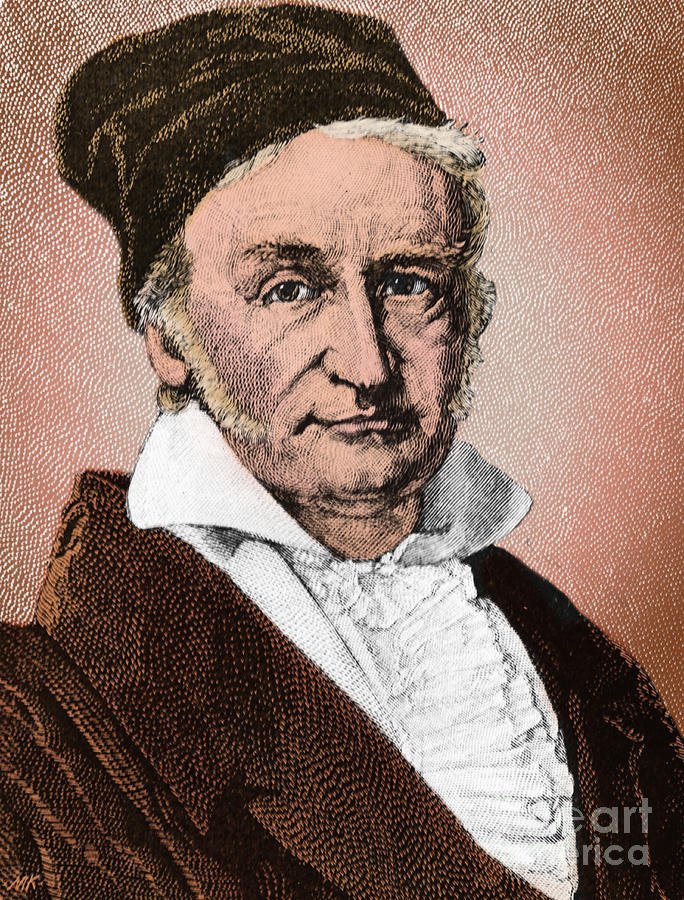Hello steemians, how are you? Hope very good.
Let's start with story.
In the late 1700s, in elementary school, somewhere on earth, there was a strange teacher. He would sleep in class giving hard problems to the students. One day, he just gave elementary school students to find the sum from 1 to 100. Within seconds, he heard the answer 5050. He checked the result and he was astonished. The student was new there and yeah you guessed it right he was Carl Friedrich Gauss.

(credit: http://www.storyofmathematics.com/19th_gauss.html)
What he had done was making pairs. He made pair of (1,99),(2,98), (3,97) ... (49,51). The sum is 4900. Now, the remaining are 50 and 100, adding both we get 5050.
The famous works of Carl Friedrich Gauss are described in brief below.
i. Prime Number Theorem
Prime numbers are infinite was proved by Euclid 300 BC but its distribution is vague till now. How many prime numbers are there up to number n? This is the famous problem in mathematics which goes till the Riemann Hypothesis which is still unsolved and among Millennium Problems by Clay Institute of mathematics.
let us consider π(N) be prime counting function i.e. it gives a number of the prime numbers less than or equal to natural number N.
π(1) = 0, π(2) = 1, π(3) = 2, π(4) = 2 ...
Also,
Let, define log(x) function such that,
log(x) = a
means, e^a = x
Here, e is an irrational number called Euler number. It is limit of (1 + 1/n)^n as n tends to infinity.
| N | N/π(N) | log(N) |
|---|---|---|
| 1,000 | 5.9524 | 6.9077 |
| 1,000,000 | 12.7392 | 13.8155 |
| 1,000,000,000 | 19.6665 | 20.7232 |
| 1,000,000,000,000 | 26.5901 | 27.6301 |
| 1,000,000,000,000,000 | 33.624 | 34.5377 |
From the table above it is clear that,
N/π(N) ~ log (N)
or, π(N) ~ N/log(N)
It is prime number theorem.
It was proposed by Gauss at the age of 15.
Later Gauss himself made the approximation little better.
Li(N)= integral of 1/log(N) from 2 to N.
Then,
π(N) ~ Li(N)
Source
ii. Gauss Laws in Electromagnetism
First two of four Maxwell equations are laws given by Gauss.
a. Gauss law of Electrostatics:
It states that the electric flux through the enclosed surface is equal to the net charge enclosed divided by the permitivity of free space.
Φ_E = Q/ε_0
This law helps to find the electric field intensity around various static sources.
b. Gauss law of Magnetism:
It states that the magnetic flux through the enclosed surface is equal to the zero.
Φ_B = 0
From this law, we know that magnetic monopole doesn't exist.
Source: Gauss law for Electricity and Magnetism
(This is just brief. For detail explanation, stay tuned and follow me :P. I am preparing vector calculus series which will include Maxwell equations and there, I will explain these in detail.)
iii. Fundamental Theorem of Algebra
It states that "Every non-constant single-variable polynomial with complex coefficients has at least one complex root".
The equation of the form x + a = b, a,b ε Z, has solution x ε Z. Z is the set of the integer.
The equation of the form ax + b = c, a,b,c ε Q, has solution x ε Q. Q is the set of rational numbers.
The equation of the form ax^2 = b a,b ε R^{+}, has solution in x ε R^{+}, the positive real number
non- constant means irreducible.
single variable means only variable generally x is taken.
Complex coefficients means coefficients are complex numbers.
The equation of the form ax^2 = b, a,b ε C, has a solution in x ε C, C is set of complex number.
Hence, the complex number system is algebraically closed.
The fundamental theorem of algebra is proved by Gauss.
Along with these main works he has done works related to astronomy, geodesic, complex analysis etc.
welcome to steemit comunity i hope you enjoy here :-)
Gauss is one of my favorite cientists.
A curious history about it is the polygon of 17 sides. He demonstrated the way to draw it when he was very young, and this particular development made that he dedides to be an academic and not a philosopher.
Good post
Good